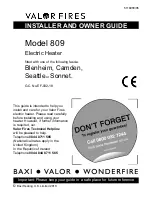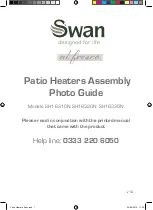
8
9
E
Cuando se enciende el calentador, una corriente de baja alternancia y elevado
voltaje pasa a través de los numerosos bobinados de la bobina primaria. Esto
induce una elevada corriente de bajo voltaje en la pieza de trabajo, actuando
como bobina secundaria. Esta elevada corriente produce el calentamiento de la
pieza de trabajo.
La corriente sólo fluye en la pieza de trabajo, y por ello es el único elemento que
se calienta. La pieza de trabajo queda automáticamente desmagnetizada al final
de cada ciclo de calentamiento.
3.
Instalación
• Retire el material de embalaje y coloque el calentador de inducción sobre una
superficie no ferrosa que sea estable y plana. La caja normalmente contendrá el
calentador, un yugo o un conjunto de yugos, la sonda de temperatura, un par de
guantes resistentes al calor y un pequeño recipiente de lubrificante.
• Verifique el voltaje de la fuente de alimentación y que la corriente cumple las
especificaciones de la placa que se encuentra en la parte posterior del equipo.
• Como hay un gran número de tipos de enchufes, no todos los calentadores por
inducción de Timken se suministran con un enchufe. Cuando el calentador no va
provisto de enchufe, un electricista cualificado tendrá que instalar uno.
• Los hilos deben conectarse como sigue; hay tres opciones dependiendo del tipo
de cable con el que se suministra el calentador:
Calentadores de 230V/110V 1 fase
Marrón
Fase
Negro
Fase
Negro“1”
Neutro
Azul
Neutro
Blanco
Neutro
Negro“2”
Fase
Verde/amarillo Tierra
Verde
Tierra
Verde/amarillo Tierra
Calentadores de 400, 450, 500V 2 fases
Marrón
Fase
Marrón
Fase
Negro“1”
Fase
Azul
Fase
Negro
Fase
Negro“2”
Fase
Verde/amarillo Tierra
Verde/amarillo
Tierra
Verde/amarillo Tierra
noticeheaterE.indd 9
17/10/06 14:04:43
Summary of Contents for VHIN 10
Page 204: ...noticeheaterRU indd 2 17 10 06 14 30 28...
Page 206: ...4 1 5 150o C 302o F noticeheaterRU indd 4 17 10 06 14 30 28...
Page 207: ...5 RU in out 1 noticeheaterRU indd 5 17 10 06 14 30 29...
Page 211: ...9 RU 3 3 230V 110V 1 2 400 450 500V 1 2 noticeheaterRU indd 9 17 10 06 14 30 30...
Page 212: ...10 4 noticeheaterRU indd 10 17 10 06 14 30 31...
Page 213: ...11 RU 5 5 2 1 in out noticeheaterRU indd 11 17 10 06 14 30 32...
Page 214: ...12 5 1 2 150 C noticeheaterRU indd 12 17 10 06 14 30 34...
Page 216: ...14 6 240 464 F VHIN10 noticeheaterRU indd 14 17 10 06 14 30 38...
Page 219: ...17 RU 8 noticeheaterRU indd 17 17 10 06 14 30 38...
Page 224: ...noticeheaterPRC indd 2 17 10 06 14 32 31...
Page 226: ...4 1 5m 16ft 150o C 302o F noticeheaterPRC indd 4 17 10 06 14 32 32...
Page 227: ...5 PRC in out 1 3 3ft noticeheaterPRC indd 5 17 10 06 14 32 32...
Page 231: ...9 PRC 3 3 230V 110V 1 2 400 450 500V 1 2 noticeheaterPRC indd 9 17 10 06 14 32 34...
Page 232: ...10 4 noticeheaterPRC indd 10 17 10 06 14 32 34...
Page 233: ...11 PRC 5 5 2 1 in out noticeheaterPRC indd 11 17 10 06 14 32 35...
Page 234: ...12 5 1 2 150 C 302 F noticeheaterPRC indd 12 17 10 06 14 32 37...
Page 236: ...14 6 2 4 0 o C 4 6 4 o F VHIN10 noticeheaterPRC indd 14 17 10 06 14 32 41...
Page 239: ...17 PRC 8 noticeheaterPRC indd 17 17 10 06 14 32 41...
Page 244: ...Notes noticeheaterGB indd 22 17 10 06 15 56 16...
Page 245: ...Notes noticeheaterGB indd 22 17 10 06 15 56 16...
Page 246: ...Notes noticeheaterGB indd 22 17 10 06 15 56 16...
Page 248: ...A1 noticeheaterGB indd 24 17 10 06 15 56 20...
Page 249: ...A2 noticeheaterGB indd 25 17 10 06 15 56 38...
















































